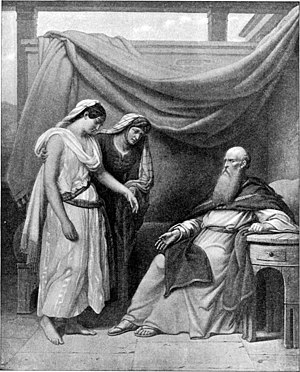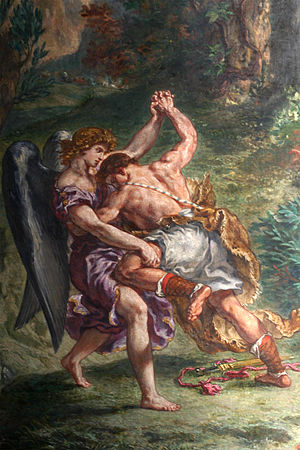Bible Patriarchs
The patriarchs (Hebrew: אבות ʾAvot, fathers) of the Bible, when narrowly defined, are Abraham, his son Isaac, and Isaac's son Jacob, also named Israel, the ancestor of the Israelites.
These three figures are referred to collectively as "the patriarchs", and the period in which they lived is known as the patriarchal age.



Judaism, Christianity, and Islam hold that the patriarchs, along with their primary wives, known as the matriarchs (Sarah, Rebekah and Leah), are entombed at the Cave of the Patriarchs, a site held holy by the three religions. Rachel, Jacob's other wife, is said to be buried separately at what is known as Rachel's Tomb, near Bethlehem, at the site where she is believed to have died in childbirth.
More widely, the term patriarchs can be used to refer to the twenty male ancestor-figures between Adam and Abraham. The first ten of these are called the antediluvian patriarchs, because they came before the Flood.
Scholars have taken a mixed view as to the Patriarchs's historicity, with archaeology so far supposedly producing no evidence for their existence, although this claim is disputed.
Definition
The patriarchs of the Bible, when narrowly defined, are Abraham, his son Isaac, and Isaac's son Jacob, also named Israel, the ancestor of the Israelites. These three figures are referred to collectively as the patriarchs, and the period in which they lived is known as the patriarchal age. They play significant roles in Hebrew scripture during and following their lifetimes. They are used as a significant marker by God in revelations and promises, and continue to play important roles in the Abrahamic faiths. Judaism, Christianity and Islam hold that the patriarchs, along with their primary wives, known as the matriarchs – Sarah (wife of Abraham), Rebekah (wife of Isaac) and Leah (one of the wives of Jacob) – are entombed at the Cave of Machpelah in Hebron, a site held holy by the three religions. Rachel is said to be buried separately at what is known as Rachel's Tomb, near Bethlehem, at the site where she is believed to have died in childbirth.
More widely, the term patriarchs can be used to refer to the twenty male ancestor-figures between Adam and Abraham. The first ten of these are called the antediluvian patriarchs, because they came before the Flood.
Lifespans
The lifetimes given for the patriarchs in the Masoretic Text of the Book of Genesis are: Adam 930 years, Seth 912, Enos 905, Kenan 910, Mahalalel 895, Jared 962, Enoch 365 (did not die, but was taken away by God), Methuselah 969, Lamech 777, Noah 950. Gerhard von Rad said:
The long lives ascribed to the patriarchs cause remarkable synchronisms and duplications. Adam lived to see the birth of Lamech, the ninth member of the genealogy; Seth lived to see the translation of Enoch and died shortly before the birth of Noah. Noah outlived Abram's grandfather, Nahor, and died in Abram's sixtieth year. Shem, Noah's son, even outlived Abram. He was still alive when Esau and Jacob were born!

Explanation of color-codes:
- Lifespans recorded in the Septuagint: Black (▄▄) and gray (▄▄)
- Lifespans recorded in the Syriac Peshitta: Gold (▄▄), yellow (▄▄), and brown (▄▄)
- Lifespans recorded in the Masoretic text: Crimson (▄▄), vermilion (▄▄), and cinnabar (▄▄)
Matriarchs

The matriarchs, also known as "the four mothers" (ארבע האמהות), are:
- Sarah, the wife of Abraham
- Rebekah, the wife of Isaac
- Leah and Rachel, the wives of Jacob
- Secondary matriarchs: Some Jewish sources list Bilhah and Zilpah (Jacob's concubines) as additional matriarchs, for a total of six matriarchs. Other sources also include an emphasis on Tamar (the daughter-in-law of Judah) and Asenath (Osnat) (the wife of Joseph).
See also
References
External links
This article uses material from the Wikipedia English article Patriarchs (Bible), which is released under the Creative Commons Attribution-ShareAlike 3.0 license ("CC BY-SA 3.0"); additional terms may apply (view authors). Content is available under CC BY-SA 4.0 unless otherwise noted. Images, videos and audio are available under their respective licenses.
®Wikipedia is a registered trademark of the Wiki Foundation, Inc. Wiki English (DUHOCTRUNGQUOC.VN) is an independent company and has no affiliation with Wiki Foundation.